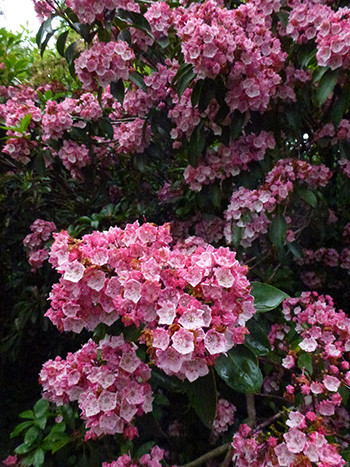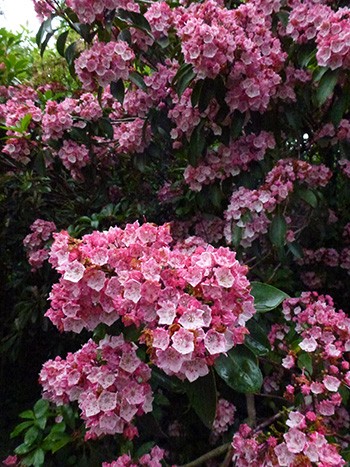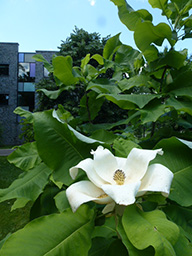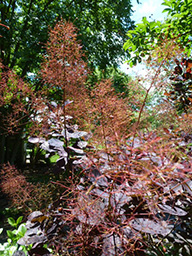
Plants of the Week: June 5
Kalmia latifolia
June has arrived and so have the delightful flowers of Kalmia latifolia, commonly known as mountain laurel. This time of the year large clusters of delicate flowers can be seen around campus. The small bright pink buds of this variety reveal soft pink cup-shaped flowers with fused petals. This evergreen shrub is Pennsylvania’s state flower known for its shade tolerance and hardiness. It prefers moist, well-drained soil and is more drought-tolerant than its relative, the rhododendron. Great plant for a woodland garden, but keep in mind it flowers best with more sun.
The genus name comes from Peter Kalm, a Swedish botanist who journeyed to the New World in 1748. In his travel accounts, he observed the shrub growing ornamentally in colonial gardens. This specific cultivar, ‘Jaynes #137’, is found along Cedar Lane near the Arboretum’s entrance on College Avenue. It is named after Richard Jaynes whose passion for Kalmia led to more than 35 years of collecting, researching, and breeding this genus. Incredibly, there are over eighty cultivated varieties with colors ranging from white, to pink, to deep rose with unique markings within the petals. Over 8 varieties can be found on campus. Photo Credit: L. Whitacre
Magnolia macrophylla
A stunning flower on the Magnolia macrophylla between Beardsley Hall, Trotter Hall, and Kohlberg Hall has recently opened. The isolated placement of this tree at the intersection of three paths allows for appreciation of the specimen from all sides.
This small deciduous tree is striking for its unusually large, floppy leaves and is even more remarkable in bloom. The large creamy-white flower is almost out of sight, located high among the enormous leaves which can reach 30 inches in length. There were are least four buds in evidence, so stay tuned for more fragrant flowers very soon! When the breeze picks up, the silver-white undersides of the leaves are revealed, contrasting against the bright green topside.
It is important to place the tree in a location sheltered from the wind as the leaves can tear. Interestingly, trees are at least 12 years old when they begin to flower and are typically pollinated by beetles, as bees and butterflies did not exist when this species evolved. Photo Credit: L. Whitacre
Cotinus coggygria
Walking south from McCabe Library towards Old Tarble, the seed clusters of the Cotinus coggygria are billowing in the wind. ‘Purple Supreme’ is a medium sized multi-stemmed shrub that one could add to the garden as an accent for summer and fall appeal.
This deciduous shrub prefers sun and good drainage, reaching 10 to 15 feet in height and similar spread. The lush reddish, purple leaves create a lovely pop of color against surrounding green vegetation so it’s a perfect focal point plant in a border or mixed bed. After flowering, long plume-like seed clusters have emerged from the flower stalk creating the ‘smoky’ or hazy, soft halo presence.
This effect continues through the summer. In the autumn, the leaf colors become richer. Photo Credit: L. Whitacre








No Comments